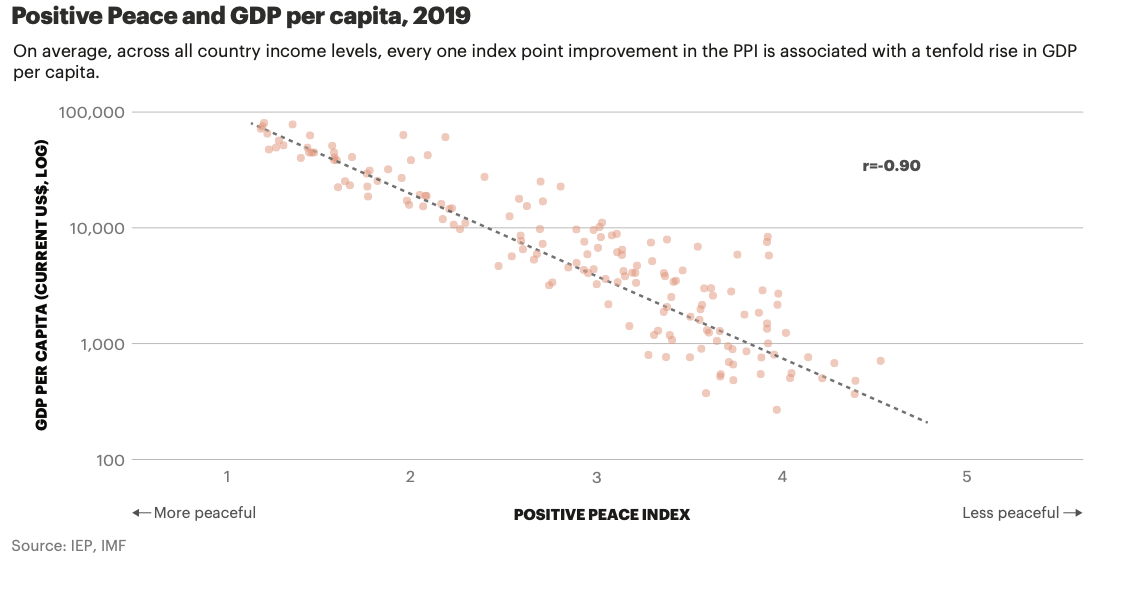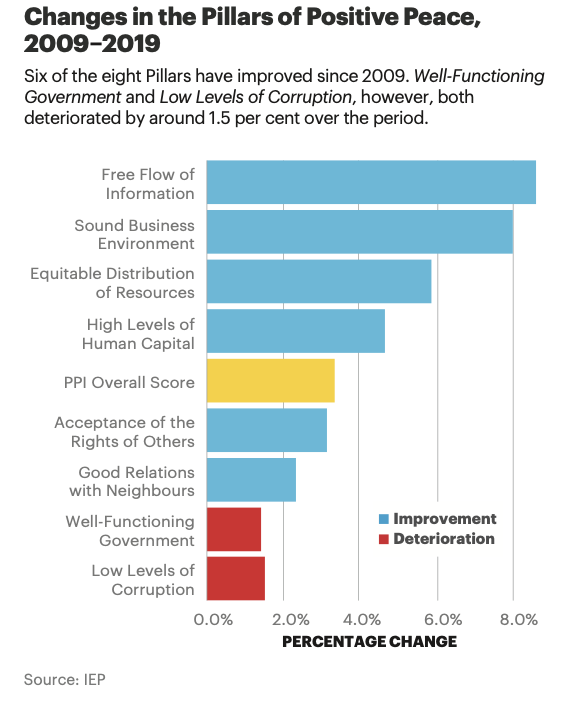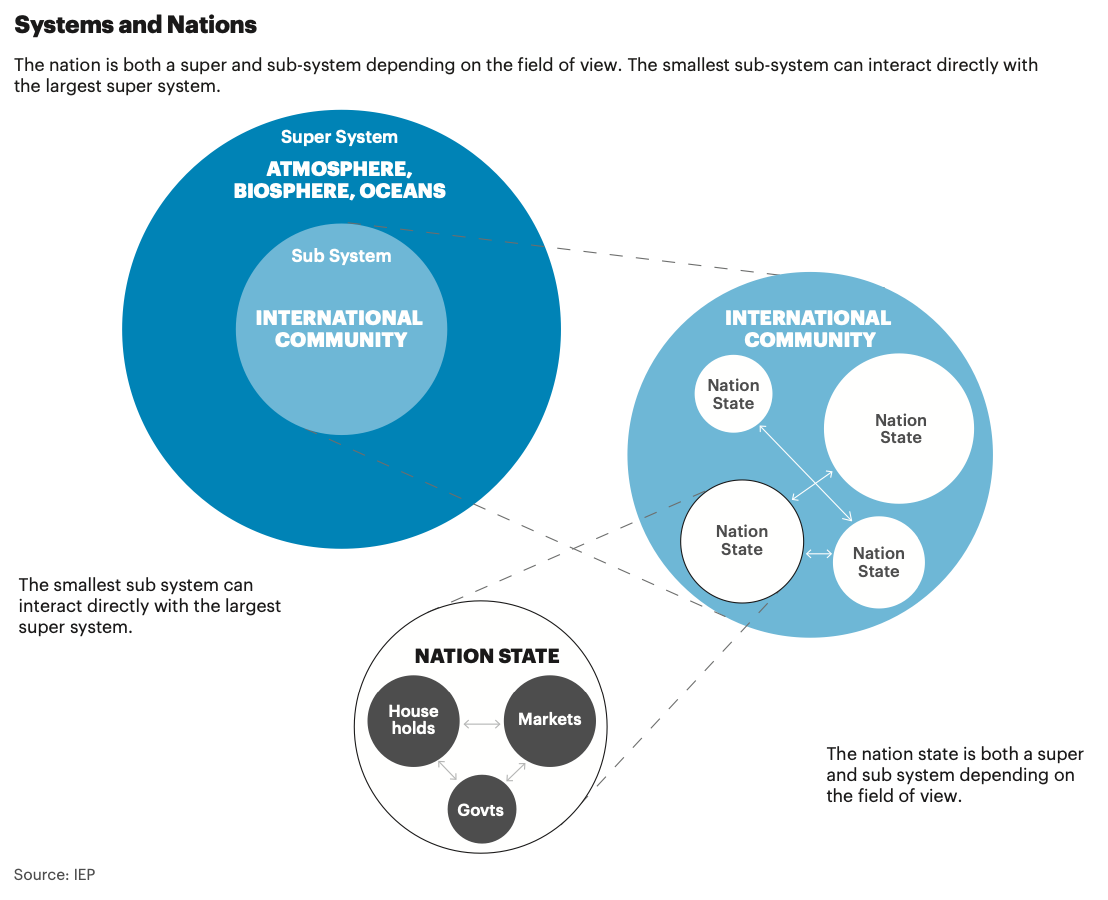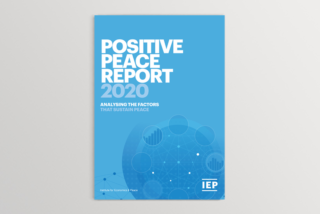This report details the latest findings from IEP’s research into Positive Peace, including country rankings and their changes over time. The report also analyses the relationship between development and Positive Peace, finding that Positive Peace acts as a catalyst for better development outcomes.
Positive Peace is defined as the attitudes, institutions and structures that create and sustain peaceful societies. The same factors that create lasting peace also lead to many other positive outcomes that societies aspire to, including:
Other factors that improve with Positive Peace are measures of inclusiveness, wellbeing and happiness. Therefore, Positive Peace can be described as creating an optimal environment for human potential to flourish.
Positive Peace is conceptually and empirically linked to socio-economic resilience. Countries with high Positive Peace are more likely to maintain their stability and recover more easily from internal and external shocks. Through the modelling of the relationship between Positive Peace and the actual peace of a country, as measured through the Global Peace Index (GPI), it is possible to predict large falls in peace. A model based on Positive Peace deficits was able to predict 90 per cent of the countries that would deteriorate in peace over the past decade. Additionally, seven of the ten largest falls on the GPI were also predicted by this model.
The data used in this report covers the period from 2009 to 2019. As such, it does not include the impact of the COVID-19 pandemic, lockdowns and the global recession that ensued. It will be included in forthcoming editions of the Positive Peace Index (PPI), as well as other upcoming IEP publications such as the GPI and the Business and Peace report.
Analysis finds that Positive Peace is strongly correlated with better economic outcomes. Countries that develop high levels of Positive Peace display greater degrees of economic strength and resilience. Countries that improved in Positive Peace between 2009 and 2019 had annual per capita GDP growth almost three percentage points higher than countries that deteriorated in Positive Peace. As such, Positive Peace can be used in financial markets helping investors identify reliable and sustainable growth opportunities. In addition to improvements in GDP, Positive Peace is statistically associated with better performance in a range of other macro-economic indicators, including stronger flows of foreign direct investment, appreciating currencies and lower and more stable interest and inflation rates.

Trends in Positive Peace can be used to forecast future economic outperformance in countries. This is an invaluable tool for financial analysts seeking to complement their traditional macroeconomic forecasting models. This analysis is discussed in this report and will be further developed in the upcoming Business and Peace publication.
Positive Peace is also conceptually and empirically linked with the notion of ethical investing, or as it is often described, environmental, social and governance (ESG) investing. Positive Peace is statistically linked to improvements in ESG measures and as such can be seen as creating the background environments where countries will perform well in such measures. Positive Peace can be used as a predictor of superior ESG performance and can be applied in the design of impact- type investment strategies or as a risk assessment and management tool.
Global levels of Positive Peace have improved since at least 2009, with 134 of the 163 countries, or 82 per cent, improving in the PPI over this period. Positive Peace improves slowly, therefore planning needs to be longitudinal. Much of the progress since 2009 is due to improvements within the Structures domain of Positive Peace, which includes measures related to economic, technological and scientific development. They tend to grow almost uninterruptedly, reflecting the continuous increase in national incomes, the constant development of new technologies and the permanent stream of new discoveries in science and health.
In contrast, factors relating to social behaviour and social relations, as measured by the Attitudes domain, have deteriorated considerably over the past decade. These factors measure social views, tensions and perceptions and have been negatively affected by a rise in corruption, greater polarisation of political views, the intensification of tensions between social groups and the dissemination of false information. Some countries have experienced steep declines in this domain, including developed countries, such as Denmark, the Netherlands, Austria, the US and the UK.
Six of the eight Pillars of Positive Peace have improved over the last decade. The Pillars with the greatest improvements were Free Flow of Information and Sound Business Environment. These developments mostly reflect the dissemination of information technologies and the growth in goods and services consumption and trade. High Levels of Human Capital also improved markedly, on the back of greater access to education and professional training. It was also influenced by increased technical and scientific research output.

However, the Pillars Low Levels of Corruption and Well- Functioning Government, deteriorated globally. Either corruption itself has become more prevalent over the last decade or perceptions of it have deteriorated. Overall, Low Levels of Corruption deteriorated in 103 of the 163 countries assessed by the PPI. In line with these developments, governments have also become less effective and reliable, with the Well-Functioning Government Pillar deteriorating in 98 countries since 2009. These are serious concerns.
The research also incorporates systems thinking, which provides a more accurate understanding of how nations operate and societies develop over time, rather than the traditional approach of cause-and-effect linear thinking. The introductory section of the report describes the fundamental concepts associated with systems thinking. Adopting this approach, IEP develops a new interdependent framework and holistic methodology to the study of peace and societal development.
When combined with systems thinking, the analysis of Positive Peace produces a new theory of social change. Developments in Positive Peace precede societal changes in peacefulness, either for better or worse. Stimuli and shocks have cascading effects, due to the feedback loops contained within national systems, pushing societies into virtuous or vicious cycles. However, these cycles can be understood, planned and moulded to produce the best social outcomes. Positive Peace provides a roadmap of the things societies need to change, to either consolidate virtuous cycles or break vicious ones.

Each Pillar of Positive Peace represents a complex set of social dynamics. Research finds that different Pillars become more important at distinct stages of development. In low-peace countries — those struggling with external wars, civil wars or internal insurgencies — improvements in the Pillars Low Levels of Corruption, Acceptance of the Rights of Others, Good Relations with Neighbours, Sound Business Environment and Well-Functioning Government are critical for the reduction of violence. As countries progress toward higher levels of peacefulness, further reductions in violence require improvements in Free Flow of Information, Equitable Distribution of Resources and High Levels of Human Capital. The eight Pillars build on one another to consolidate previously acquired successes.
Additionally, improvements in a single Pillar, without improvements in other supporting Pillars can lead to a higher likelihood of deteriorations in peace. Focusing exclusively on building stronger business environments or higher levels of education, for example, may prove to be problematic. Countries, like systems, evolve and therefore the unique factors which constitute the make-up of a country need to be understood for interventions to be successful. Radical change also creates instability and risk. The best approach is many small, progressive nudges towards virtuous cycles of greater Positive Peace. Once a cycle is underway, it tends to be self-reinforcing. This is the nature of systems.
Taken together, the findings in this report have important implications for building and sustaining peace:
• There are no quick and easy solutions. Building and sustaining peace requires a large number of society-wide improvements progressing in concert with one another over long periods of time.
• Simply addressing the factors that led to violence in the past will not be enough to sustain peace in the future. Different aspects of the social system push societies towards or away from peace, which means that improvements in peace require broader and more systemic strategies than once thought.
• Prevention should be the priority. Recovery after violence has already occurred is difficult, expensive, and requires widespread effort to rebuild Positive Peace. Through focusing on the factors that are most critical, it is possible to build resilience in cost-effective ways.
• Stopping or averting conflict is not an end in itself. As Positive Peace progresses, it enables an environment where human potential may more easily flourish.
Positive Peace can also be applied practically through workshops and development projects on a national, state or community level. IEP has implemented workshops in all major regions of the world. Included in this report are examples of IEP programmes conducted in the Philippines, Ethiopia, Mexico, Uganda and Japan, all aimed at building Positive Peace in these countries and communities.
Without a better understanding of how societies operate, it will not be possible to solve humanity’s major global challenges. Positive Peace provides a unique framework from which to manage human affairs and relate to the broader ecosystems upon which we depend. Positive Peace in many ways is a facilitator, making it easier for workers to produce, businesses to sell, entrepreneurs and scientists to innovate and governments to serve the interests of the people.
🇸🇴 1. Somalia
🇾🇪 2. Yemen
🇸🇸 3. South Sudan
🇪🇷 4. Eritrea
🇨🇫 5. Central African Republic
🇹🇩 6. Chad
🇸🇾 7. Syria
🇨🇩 8. Democratic Republic of the Congo
🇬🇶 9. Equatorial Guinea
🇸🇩 10. Sudan
This means the world has become richer and more apt at technology, but the ways in which we treat one another have become measurably more intolerant.

This report details the latest findings from IEP’s research into Positive Peace, including country rankings and their changes over time. The report also analyses the relationship between development and Positive Peace, finding that Positive Peace acts as a catalyst for better development outcomes.
Read the report